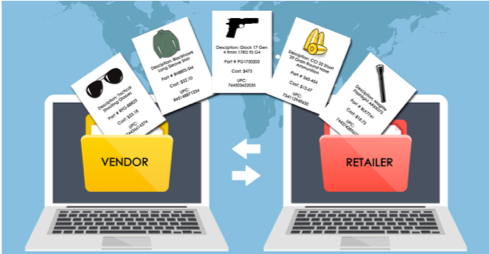Using Electronic Vendor Catalogs to Improve the Firearm Industry Supply Chain
In the world of modern supply chain management, technology is driving manufacturers, distributors, and retailers to be more proficient when handing products and product data. Current supply and retailing methods, such as, ‘Just-in-time’, auto-replenishment, and eCommerce dictate that product data, and the management of inventory, be as accurate as possible. From purchase order creation to report generation, accurate item information plays a pivotal role in effective execution of many retailing and manufacturing operating procedures.
Creating the Foundation for Accurate Inventory
For a shooting sports retailer, allocating time and resources to ensuring product information in the Gun Store POS is accurate will be time well spent. Creating policies that identify product data fields that must be populated in order for the entry to be added to the inventory management system may be necessary. Preferably, the retail POS/Inventory Management System (IMS) being utilized will ensure adherence to policy by requiring many, if not all, of the essential data fields.
Essential Product Fields
| Product Field Name | Quality Consideration(s) | Area(s) of Impact |
| UPC | Validate 12-digit UPC | Transaction Speed and Accuracy @ POS |
| Description | Avoid industry jargon and truncated wording | Meaningful receipt and eCommerce descriptions |
| Dept./Class | Assign existing Dept/Class categories – avoid creation of new depts/classes unless necessary. | Purchase Order Creation, Report Accuracy and Usefulness, Forecasting. |
| Cost/Price | Validate during Receiving and/or Invoicing. Apply GP% (markup) against cost | Profitability |
| Distributor Part Number | Track unique part number from every Dist. the item is available. (often is not the same as the manufacture part number) | Profitability, Purchase Order Accuracy, Receiving History |
| Manufacture | Lookout for duplicates and variations. Ex. Smith & Wesson – S&W – Smith and Wesson | Reporting, Purchase Order Creation |
| ATF Regulated Fields | Some vendors provide an initial review of ATF regulated fields (Manufacturer, Model, Caliber, Type and Importer | Improved ATF Compliance and Decreased Labor Requirements |
A well-organized retail store will assign an employee to specialize in the maintenance of the item/product data. In larger retail firearm operations, a specific position – Inventory Controller – may be created to handle all things related to the product life-cycle, including the creation and maintenance of item information and event regulated, ATF controlled data. For small and mid-sized gun stores, this duty is often given to an existing position. Ideally, the person assigned this responsibility should rely on this data to perform the other duties of their job and have ‘skin in the game’. Receiving personal or buyers are often good choices when considering an existing employee to manage this important task. Their intimate knowledge of how the product is sold, merchandising location, and understanding of its intended use will serve the employee well when adding a new product or editing an existing entry.
Synchronizing Inventory Digitally
The use of electronic Vendor Catalogs (e.g., firearms, ammunition and accessories) can greatly decrease time spent doing data entry while increasing the integrity and accuracy of the product information in the retail inventory system. Most shooting sports distributors and manufactures have their entire product line cataloged electronically and have made it available to retailers. The electronic catalog will contain all the relevant product information [as outlined above] and can be referenced as an excel document or, ideally, directly loaded into a Retail Firearm Point of Sale or Inventory Management System.
The initial benefits of downloading vendor catalogs into the POS/IMS are immediate speed and efficiency gains. The ability to pull entire product lines into the system with a few button clicks will eliminate the pain-staking process of keystroking tens of thousands of characters; saving hundreds of labor hours. Furthermore, the quality of the information being imported form an electronic catalog will be far more consistent and accurate than that of entries that are manually input. Typically, the data found in an electronic vendor catalog is the same data the distributor/manufacture is using for their own internal purposes, so a user can be confident the information is well groomed and updated regularly.
Realizing the value of electronic vendor catalogs, it may be tempting to import every shooting sports distributor’s entire catalog directly into the inventory table within the retail POS, however, it should be warned; inserting 100,000 items into the database may have unintended consequence, particularly if many of the items added have never been – or ever will be – sold on the retail floor. Reports being run at the item level will be much larger and harder to digest with the inclusion of the many arbitrary additions. Furthermore, the speed which the reports render may be affected by the additional computing required to analyze the larger data set.
Preferably, only the items that are stocked – or intended on being stocked – would be parsed out of the entire list before being imported into your inventory. Quality gun store inventory management software will provide a separate area within the application to store and manage the vendor catalogs. The software should provide tools to search and selectively migrate items from the vendor catalog file into the live inventory. It should also be able to use the vendor catalogs to build a cross reference table, that is to say, if an item can be had from more than one distributor, the software should be able to house each vendor’s unique part number (and cost) against the single item entry (UPC) in the system. This is particularly useful when creating a purchase order, so the system can use the appropriate item part number depending on the intended source.
Adopting modern supply chain and retail methods will require leveraging of technology and the application of controlled inventory practices. Building a thoughtful and accurate item/product table will provide the foundation from which all processes associated with the new business model can be built.







0 Comments